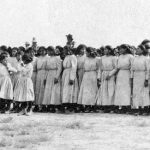
Sometimes the Barbarian seems to be the Civilized Man. Sometimes the Civilized Man seems to be the Barbarian. —Benson J. Lossing, 1870 In late October, 1907, my great grandfather, John Wetherill, was making his way up the San Juan…
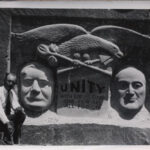
Beginning in the late 1930s and for the next 12 years, Christensen would create his remarkable 5000 square foot home—his ‘Hole ‘n’ the Rock—from the surrounding Entrada Sandstone. And for many years, from 1945 to 1955, part of the man made cavern was a diner. It had a reputation for being a bit on the wild side. Though Hole N’ the Rock was in San Juan County, it was almost 40 miles from Monticello, the nearest community in the county. Moab was much closer, but Grand County lacked jurisdiction. The diner and the store and its reputation flourished and the Christensens eked out a modest living.
Still, Albert’s most impassioned work, and the project that was to first create such excitement and interest, and then later cause such profound disappointment and heartbreak, was his ‘Unity Monument.’
It was to be Albert Christensen’s grandiose effort to honor President Franklin Roosevelt and his opponent, Republican Wendell Willkie in the 1940 presidential election. He planned a massive bas relief tribute in a sandstone amphitheater near his rock home, but the federal government claimed he’d built his scale model on public land…What the government did next would devastate Albert, his family, and many of Moab’s citizens.
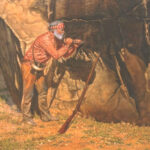
Sometime in late September or early October of 1844, Utes attacked Robidoux’s Fort Uintah trading post… One contemporary story stated that at the time of the attack, the fort had very few of its usual inhabitants present, many having already departed because of the increasing tensions with the neighboring Uinta-ats. Denis Julien seems to have been one of these.
Far to the south, in the Devils Garden section of present-day Arches National Park, is the last known, chronologically, Julien inscription. It has been scratched into the dark, desert-varnished side of a tall sandstone fin and reads, “Denis Julien 9 6 me 1844.” The “6 me ” is the French equivalent of 6 th in English, sixth in French being sixième. The preceding numeral “9” is representative of the ninth month, September…
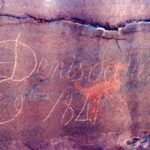
But when does a carved name on a rock stop being vandalism and take on a historic value of its own? Where do we draw the line? A century? Fifty years? I struggled with that question a lot when I was a ranger, though over the years, I came to believe that every one of these carvings is too special to be removed.
The above inscription has special meaning for me, because I found it during a backcountry patrol in 1977. It would be fairer to say I “re-found” it, many years after other humans, most likely Basque sheepherders had added their own names and comments (whether the ‘B.S.’ next to Julien’s name was an expression of doubt re: the inscription’s authenticity, of it just happened to be the man’s initials, the Julien inscription had surely been seen. but perhaps decades earlier.
I stumbled upon it purely by accident, toward the far north end of the Devils Garden. I saw the Basque inscriptions first and noticed that it was a perfect campsite. It was at the base of a small natural amphitheater—the sandstone tower and fins blocked the weather coming from the north or east. A fifty foot stabilized dune to the west of the site protected campers from the western winds. It was only after I stood directly in front of these larger inscriptions that I noticed Julien’s name. I had heard it before and thought it was worth writing up a report on my find. I had no idea it would create so much interest…
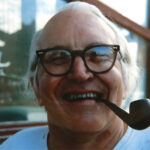
Tom Tom’s VW Museum has never been easy to miss. It’s located at the intersection of Mill Creek Drive and Spanish Valley Drive, an intersection known to locals as Chicken Corners. It’s the Gateway to Spanish Valley, where in the last two decades, many of the other junk cars and washing machines and spare tires have vanished — replaced by half million dollar faux adobe second homes and condos.
But TK’s Museum still stands. At its zenith, Arnold managed to squeeze 250 vintage Volkswagens onto a two acre lot that he bought 50 years ago. It was his pride and joy. Others still curse the site and wish some mega-billionaire would fly in, buy the property and scour his collection from the face of the earth. But Tom…or Tom Tom…or TK …always took the criticism in stride and with good cheer. “They just don’t know how to have a good time… I’m having a good time.” He did to his last breath…
For the record, he was born Thomas Arnold, but we knew him by many names— Tom, Tom Tom, TK, or more generically—The Volkswagen Guy. For decades TK serviced VWs of all kinds, with varying degrees of success. As all of us who once owned VWs, the cars were almost born with the intent to drive us crazy, and consequently, we owners were surely cursed with varying degrees of masochism. But Tom loved them all. And he loved to collect the ones that he could not revive.
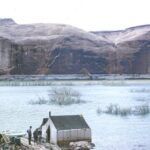
Arth Chaffin and Ruben Nielsen thought there might be non-archaeological treasures to be salvaged as well. The river had seen its share of mining operations over the last century, and even old cabins and sheds. Most of them, like Bert Loper’s old cabin, were drowned by the rising waters. But there was other possible salvageable booty, and I’m just speculating here, but they have been looking for more practical treasures, like compressors, small Diesel or gas engines, scrap iron, copper wiring, discarded tools, old drill steel, tools, ladders…the kind of material that mechanics and people tied to the mining industry might find of value.
And so Arth and Ruben built a “barge.” It was constructed from empty sealed 55 gallon drums–about fifty of them— which they lashed together and over which, constructed a deck of sorts. On the deck, they pitched two canvas tents for their personal use.